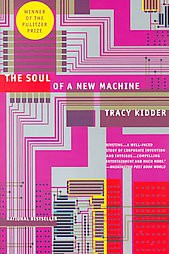"The Soul of a New Machine" Book Writeup
September 26, 2015
What’s the point?
It’s 1978. The microcomputer revolution is heating up. The deadlines are impossible, the stakes are high, and the bugs are plentiful. Data General is racing to build a 32-bit computer in one year using a mix of gray-haired veterans, wide-eyed college grads, and an enigmatic manager.
How was it?
I was directed to this book after reading the epic “What is Code” article. I was particularly drawn to the fictionalized conversations between a scrum master and an executive in the article. “The Soul of a New Machine” is an anthropological look at how technology projects in the late 1970s operated.
While there is some high-level technical content, I found the most interesting passages to be those focused on the human aspects of the team and project. Kidder profiles a wide array of colorful personas:
- Tom West, the mysterious Steve Jobs-ian figure leading the vision
- Carl Alsing, the second-in-command: “It was kind of like recruiting for a suicide mission. You’re gonna die, but you’re gonna die in glory.”
- Ed Rasala, head of hardware, debugging with a logic analyzer late into the night
One thing that stuck with me after reading was West’s concept of “signing up”. By signing up for the project, you were agreeing to do “whatever was necessary for success”. It was a ritual of commitment; you were no longer being forced to work late, you had volunteered. At Data General, the demand for engineers exceeded the supply so managers had to really sell their projects to get the team members to “sign up”.
The implication that one would abandon friends, family, and free time for a project is not something I plan to try out, but I did like the concept of a semi-official act of saying “Yes, I will work on this”. It seemed similar to the open allocation style of management, which seems appealing to me.
Who should read it?
Closer to fiction (though it is all factual), I found this an enjoyable change of pace from my normal reading material. Those interested in team/project dynamics or just some good, old-fashioned war stories should give this book a shot.

